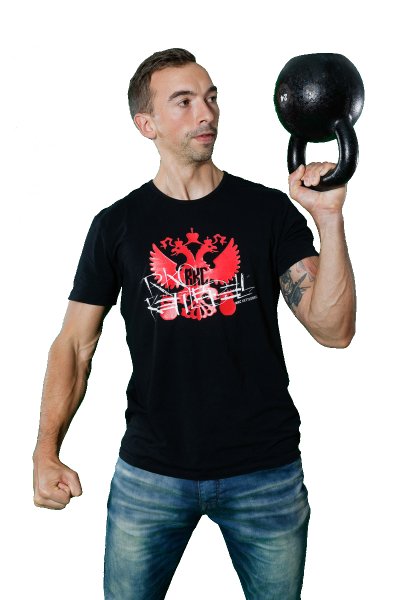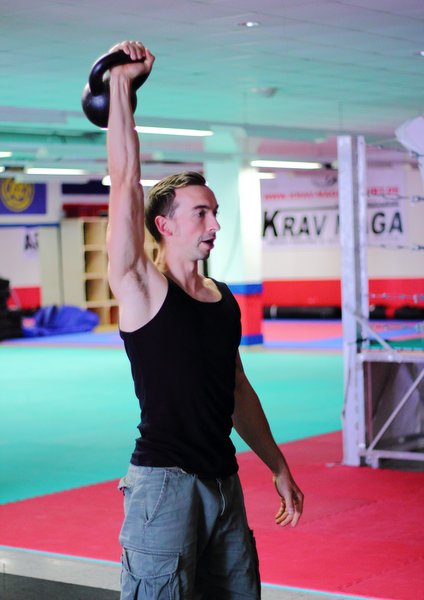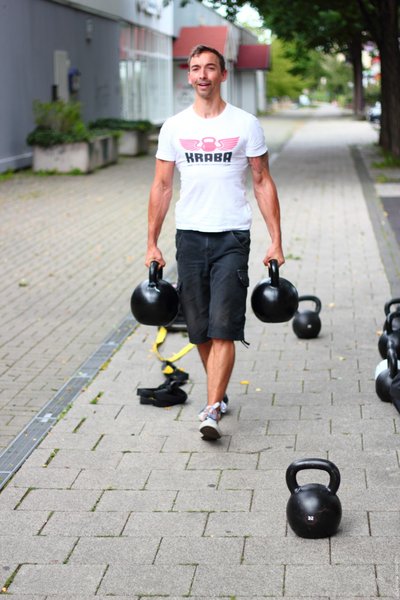
When I started training with kettlebells, and right after I went to a beginner’s kettlebell seminar, it was really frustrating for me to only have a very restricted number of exercises for my training.
I asked myself, “How can I train my whole body with only these few exercises?”
Well, back then I had no clue and had not yet learned the “real” kettlebell training principles. I was taught the basics at the seminar, but I didn’t totally comprehend them. Understanding them took a much longer time.
So I started training by myself, and it ended up taking me a year or longer to fully understand kettlebell training and how I could really use it.
Here are four things that helped me get much more out of my kettlebell training:
1. Strength is a skill.
“How obvious is that slogan?” I thought when I’ve heard it for the first time. Of course, strength is a skill, just like endurance, speed, and mobility. It’s also a matter of how in shape or fit you are. Why are the guys making such a fuss about it?
“Train with kettlebells and you’ll become stronger”, I always thought. But when I understood that I had to train the skill of “strength” to become strong, that’s when I started to get the real benefits from the training. I stopped counting sets and reps and started to practice, to grind movement patterns. I worked on improving my technique and listening to my body while I was practicing.
A good example to explain this “skill” approach is the handstand. When I want to start training handstands, I can’t just start off with the idea like, “Today I’ll do 3 reps of handstands, where I stand for 30 seconds unsupported in the middle of a room”. That’s not how it works. Instead, you should practice handstands. You need to feel what’s important for doing a handstand—when, where and what muscles need to be used. Even if that means 20 attempts at 3 seconds against a wall in the beginning. If you are paying attention, you’ll know when you need to stop, your body will tell you the exact moment (and I don’t mean total muscle failure).
It’s the same with kettlebell strength exercises. If you want to improve your strength efficiently, you need to first master the movement itself. When you’ve learned what and when to contract, and how this movement pattern feels with a certain weight, it is easy to develop strength. If you can’t press one weight it means you’re only allowed to practice that movement with lighter weights.
2. Quality before quantity.
Quality before quantity counts especially when practicing. Once you’ve mastered a movement with weights, movement quality should always be at the forefront. If quantity is more important to you, then reps and sets will always be more important to you than the quality of the movement and body perception.
If you are doing 1 set of 10 reps with a perfect technique, followed by 2 sets with 10 miserable reps just to get to 30 reps, what will your body learn from this session?
I’ll tell you. Your body will get really good at forcing itself through routines. No matter if it needs to compensate here or there, over time, the faulty pattern will be reinforced. Unfortunately, that’s exactly what you see with many recreational athletes. This quantity approach will work until the unavoidable injury and then it’s too late.
What the head commands, the body will always carry out!
So, practice and train smart. Quality is king!
3. Kettlebell training trains the entire body.
At first, I always thought that many different exercises were necessary to ideally train the whole body. That was why I was not satisfied after my beginner kettlebell course. This idea mainly came from my own training history. Today, I know that I can train my entire body with just a few exercises with better results than when I was using 10 different exercises for the same purpose.
There is a big difference in knowing that kettlebell training equals training the entire body and understanding kettlebell training equals training the entire body.
Often, people will ask for more exercises after a few reps of double swings followed by double clean & presses. Instead they should relax, because they have already trained their whole body.
I can’t stress that idea enough—if you practice and train correctly, you are using your whole body on each kettlebell exercise. All muscles need to work together efficiently. Sure, you can always focus on a specific body part, but you are always demanding your body as a whole.

4. 80% is enough.
This concept is from Master RKC Max Shank and it changed my training forever.
If you can do 5 reps, only do 4. If you can do 10 reps, leave it with 8. Unfortunately, when I write about not training to muscle failure, people sometimes take that literally and just put themselves into their comfort zone. Then 80% quickly become 50% or less.
When I write about 4 instead of 5 reps, I mean your absolute maximum of possible repetitions. If you can do 5 repetitions and not a single one more, then these are your maximum repetitions in this progression or exercise. Or, 100%.
I keep seeing clients who sometimes spare one rep of their 50% maximum. That’s unfortunately not how this principle works, and it often happens subconsciously. If you don’t know your numbers, it’s hard to know where you stand.
For that reason, it’s a good thing to test where your maximum is once in a while (always with a good spotter, please). Otherwise, it’s very likely that you will keep the reps you do too low, which is as counterproductive as always training to 100%.
Earlier, I wrote about the meaning of practicing, and here, the 80% idea works perfectly. Listen to your body. Sets and repetitions are overrated. I would view them more as flexible guidelines and not carved into stone. Your condition on a given day will always effect your training, and should not be ignored.
If you grimace horribly during training, can’t breathe during an exercise, or your technique falls apart, chances are you were training to your 101%. Pay attention and stop before this happens. Just because your plan was to do 5 sets of 5 reps with weigh X today, it doesn’t mean your condition on that day will allows it to happen.
Let me tell you something—you will still have a good session if you only do only 4 reps in the third set and possibly two in the last two sets. If these reps were your 80%, then congratulations, you suppressed your ego and trained intelligently. And another thing, the kettlebell does not excuse foolishness.

Save your 100% for competitions or challenges when it’s all or nothing, and perform your training sessions at 80%. If you are not in a competition sport, challenge yourself once a month. Try to set a record on an exercise. That will also help you to know your numbers. You are keeping a training journal, right?
It took me forever to incorporate these points into my kettlebell training, which was probably due to my training history and ego. Maybe you’re not as spoiled and have an ego knows it’s place in everyday life. If so, then get going, get yourself a kettlebell, learn the techniques, and start training!
***
Sebastian Müller, RKC Team Leader, PCC Instructor, FMS, and Primal Move Instructor, trains and instructs at the KRABA location in Wiemar, Germany. He can be contacted by email at: info@kraba-erfurt.de and his website: http://www.kraba-erfurt.de. His Blog is Vereinfachedeintraining.com